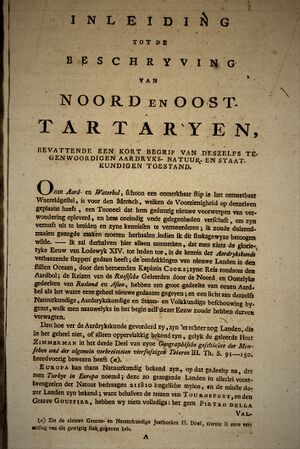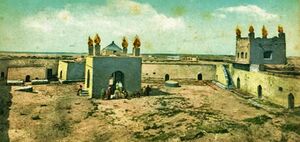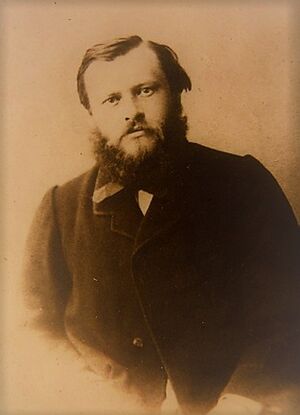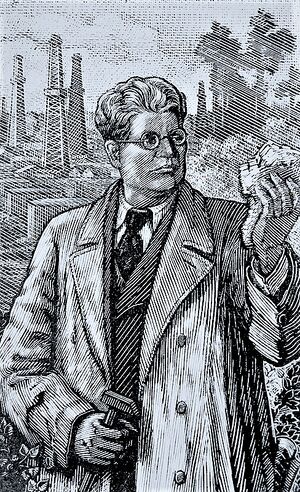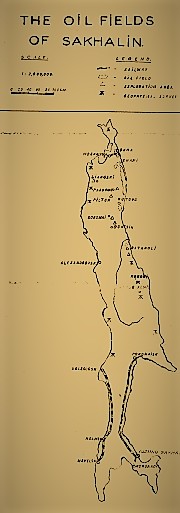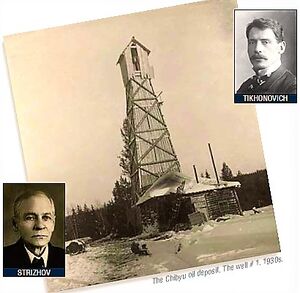Chronology of the early Russian petroleum history
The original version of this article was created by Francesco Gerali, 2020 Elizabeth & Emerson Pugh Scholar in Residence at the IEEE History Center
It is recommended this article be cited as:
F. Gerali (2020). Chronology of the early Russian petroleum history, Engineering and Technology History Wiki. [Online] Available: https://ethw.org/Chronology_of_the_early_Russian_petroleum_history
15th century. Medieval Russian sources mention the common practice of petroleum harvesting in the territories of the Muscovite state.[1] The Dvina Chronicle (Letopisets Dvinskii) states that the tribe of the Chudes on the banks of the Ukhta River filtered oils from the river surface to use it for household purposes.
1692. The book Noord Oost en Tartarye (North and East Tataria) published in Amsterdam by Nicolaes Witsen[2] (1641-1717) reported: "The Ukhta River is a day away from the village of Pechora. On this river is a small spot where oil, that is black petroleum, separates from the water" (Fig.1).
1745. In the region of Ukhta (the modern-day Republic of Komi)[3] hand-dug shafts were used and petroleum was refined in the workshop of the local entrepreneur and engineer Theodore Fyodor Pryadunov[4] (1694-1753).
1834. Mining engineer Nikolay Ivanovich Voskoboynikov,[5] graduate of the Mining Cadet Corps in Saint Petersburg and director of the Baku and Shervan salt and oil fields starting in 1826, designed a prototype device to distill kerosene from thick bitumen and fluid petroleum.
1837. Upon the project of Voskoboynikov, the Minister of Finance of Russia Yegor Kankrin granted funds to build the first large scale distillation plant on the Absheron Peninsula. It was erected in the area of Balakhani (today Balaxanı), a borough of Baku.
1842-1843. On the basis of his experience with salt waters, Voskoboynikov, while working for the Corps of the Mining Engineer, proposed drilling for petroleum by mean of mechanical equipment (percussion system). Voskoboynikov hypnotized that petroleum, like salt water, would flow out of the small borehole due to the natural pressure.
1846-1848. The drilling program of Voskoboynikov remained suspended for three years due to legal and financial issues. He decided to retire in 1846 and his project was continued by his young assistants, the cadets Kazimir Junzil and Ivan Komarov.
1858-1859. Russian entrepreneurs Vasily Kokarev, Peter Gubonin and German baron N.E. Tornow built the first refinery in the city of Surakhani, close to the famous Baku Ateshgah,[6] or Temple of Fire (Fig.2). The plant was engineered to produce kerosene out of kir,[7] the name used by the locals to indicate bituminous asphalts.
1859. The pharmacist N.I. Vitte from Tiflis, modern-day Tbilisi in the Republic of Georgia, built a paraffin refining plant on the Pirallahi island.
1863. Javad Malikov built a kerosene distilling factory in Baku.
1868. Mikhail K. Sidorov (1823-87) pioneered petroleum explorations in North Russia using the spring pool system with a set of eight-inch pyramidal bits and driving pipes. In early 1872, he equipped his crew with a Pennsylvanian cable tool system assembled in St. Petersburg and hired the Austro-Hungarian geologist Hans Höfer von Heimhalt (1843-1909) to study the area. Eventually, petroleum was found in commercial quantity in September. This date is considered the beginning of the modern North Russian petroleum industry.
1870-1880. Vladimir Vasilyevich Markovnikov (1837-1904) studies and describes of a new class of hydrocarbons called naphthenes (FIG. 3)
1873. This year marked the beginning of petroleum drilling in an industrial scale in Russia. In July, the first major oil gusher - Vermishevsky - erupted in the area of Balakhani. Within three months, it had produced 90 million poods - about 1.5 million tons of petroleum. Robert Nobel, the eldest brother in the Nobel family, visited Absheron peninsula for the first time to gauge the potential of the petroleum business of the region.
1874. Vasily Kokarev (1817-1889) and Peter Gubonin founded the Baku Oil Society Company.
1875. The Nobel brothers Ludwig, Robert and Alfred started their activities in Azerbaijan petroleum industry.
1876. Biologist Konon Lisenko,[8] Chair of Chemistry for the St. Petersburg Mining Institute, visited Baku to study the possible origins of the 1875 petroleum crisis that affected the Russian Empire. In 1878, he published a monograph in St. Petersburg called Oil Production, According to the Latest Data. The monograph was the first original, comprehensive petroleum-related publication ever written in Russian.
1878. The area of Bibi-Heybat had the first giant gusher in its producing history. Engineer Vladimir Shukhov (1853-1939) supervised the laying of the first pipeline from Balakhani to the Black City.
1879. In March, the Baku Department of the Royal Russian Technical Society was established. The Society played a key role in the development of petroleum sector in Azerbaijan (FIG. 4).
- The first petroleum fueled power station is built by the Caucasus and Mercury Joint Stock Company.
- The Russian scientist Dimitri Ivanovich Mendeleev[9] published the most important article of the time to support the inorganic origin of petroleum. [10]
- Construction of the Caucasus railroad was completed. This 514-verst (a Russian verst corresponds to 1.067km) railway system connected the industrial city of Baku to the port city of Batum (today Batumi in Georgia).
- The Rothschild Brothers established the Caspian and Black Sea Oil Industry and Trade Society.
- Movsumbey Khanlarov was the first Azerbaijani Ph.D. graduate in chemistry at the University of Strasbourg University. Returned to Baku, he began working in the Baku Department of the Royal Russian Technical Society upon recommendation of Mendeleyev,[11] who was aware of the need for foreigner knowledge and expertise in petroleum.
1882. After the establishment of the Geological Committee of Russia, the petroleum potential of the northern territories eventually started to be systematically explored also on the base of the first reliable geological map of that area prepared in 1846 by Graf Alexander A. Keyserling. The latter in his Scientific Observations on a Trip to the Pechora Region in 1843 wrote numerous references on Ukhta petroleum which revealed to be very useful.
1883. The Baku-Batum railroad is completed: Russian petroleum can now reach the Black Sea more easily and carrying larger quantities.
-The Russian scientist, N. Petrolf, is possibly the first to demonstrate scientifically the value of petroleum oils as lubricants.
-The British petroleum chemist and consultant Thomas Boverton Redwood following a research journey in the Caucasus, published On the Present Position & Future Prospects of the Russian (Caucasian) Petroleum Industry (Waterlow & Sons Limited, London) in the UK. The book is one of the few early technical outlooks on petroleum in southern Russia written by a western practitioner in the field.
- The petroleum corporation Neft was established in St. Petersburg. It was the first wholly Russian company with an internal vertical structure - committed in exploration, production, storage, refining and trading - to invest large capitals in the Ukhta region, when the focus on the powerful foreigner competitors (e.g., the groups led by the families Nobels, Rothschilds and Vishau) was exclusively in Azerbaijan.
1884. Thomas Urquhart (1843-1904), American engineer working for the Grazi-Tsaritzin Railway, after 10 years of research and experimentation on fueling locomotives with petroleum published his pioneering findings,[12] which proved to be very influential in the work of future engineers.
- In Baku, a special organization of entrepreneurs called the Council of Baku Oil Industrialists was established under the directorship of Ludwig Nobel until 1888.
1885. German chemist and professor Carl Engler visited Baku to study hydrocarbons in the Absheron.
1886. The first Russian kerosene reaches the west coast of India when Frank Lane of Lane & McAndrews begins shipping oil consigned to merchants in Bombay.
- The Pennsylvania Railroad company sent the chemist Dr. Charles Benjamin Dudley[13] (one of the founders of the American Society for Testing and Materials in 1898) in Caucasus to study in southern Russia how petroleum in locomotives was utilized. He finds the method of burning petroleum to be efficient, but the use of coal was less expensive.
- Dmitry Ivanovich Mendeleyev[14] published Baku Oil Industry to 1886 summarizing the results of his oil-related investigations from the 1860s to 1886.
1887. In January, the journal "The Works of BO IRTO" is published, the first Russian technical periodical focused on the issues related the national petroleum industry.
1889. In St. Petersburg, a special Russian Nobel Prize was established and named after Ludwig Nobel. The award was appointed annually to those individuals who succeeded in applied research for metallurgy and petroleum.
1890. Sir Boverton Redwood and James Dewar developed a specific pressured-distillation process capable of increasing the yield of lamp kerosene from Russian heavy crude oil. Although the potential, the patent did not find wide application.
1891. Vladimir Grigoryevich Shukhov[15] (1853-1939), together with Sergei Gavrilov, were the Russian physicists and engineers who in 1891 successfully developed a continuous thermal cracking process in Tsarist Russia, after having worked in applied oil field technologies (e.g. pipelining and boilers) for The Petroleum Production Company Nobel Brothers Limited (Branobel) since 1878. The Shukhov Cracking Process was first patented in Russia (no. 12926) on November 27, 1891. The base principle of the process involves the thermal breaking of the heavier hydrocarbon chains under high pressure to obtain lighter and shorter chain fractions.
1897. Beginning of the construction of the longest pipeline for refined products (829 verst, or 885 kilometers) to connect Baku and Batum. The pipeline belonged to the Trans Caucasus Railroad company.
1898. The Rothschild brothers founded the Mazut Transportation Society. By 1912, the company built a fleet of 13 tankers in the Caspian Sea.
- Petroleum production of Russia surpasses for the first time the output of the United States. Same record will be achieved in 1899 and 1901.
1906. The first massive gusher well of light yellowish, and more valuable, petroleum is achieved in Surakhani.
1908. Geologist Nickolay N. Tikhonovich (1872-1952) led the great geological exploration in the inner lands of the Sakhalin Island, the easternmost possession of the Empire, which resulted in the identification and mapping of several petroleum regions.
1909. The bay in front of the town of Bibi-Heybat Bay starts to be filled up with earth and debris (a process completed only in the early 1930s). The goal of this massive project, directed by the engineer Pavel Pototsky, aimed to facilitate the exploitation of the seabed of the bay. Off-shore drilling technology of the time was too rudimentary to allow such endeavor.
1910. The Russian chemist S. V. Lebedev develops the first commercial process[16] to convert butadiene into a rubberlike material.
1911. The first petroleum well drilled through the rotary system is achieved in Surakhani (today Suraxanı, east of Baku) by the engineer Von Gaber.
1912. Matvey Alkunovich Kapelyushnikov experimented early turbodrill prototypes in Azerbaijan. From 1914 to 1937 was director of the bureau established to develop turbodrill technologies in Russia. Between 1922 and 1925, Kapelyushnikov in cooperation with engineers S.M. Volokh and N.A. Kornev from the Mechanical Department of Tomsk Technological Institute[17] developed and patented the single stage geared working through a high-speed (1800 to 2000 rpm) mud turbine equipped with a reducer set to drive rock bits at speeds of 50 to 100 rpm. The machine was featured by a complex planetary gear system (1 to 3 stages) operating into a sealed lubrication system. 200 up to 300 Gpm (gallons per minute, corresponding to 757 to 1135 litres) of mud were pumped through the nozzle at velocities of about 200 feet per second (corresponding to 61 metres per second) producing power outputs of 12 to 15 horsepower. This invention laid the foundations for the history of turbo drilling in Russia, and it is remembered as the Kapelyushnikov’s turbodrill.
1913. Ivan Mikhailovich Gubkin (1871-1939), who later became known as the founder of petroleum geology in Russia, began to study the petroleum geology in the Absheron peninsula. His studies were pivotal in the discovery and development of new productive formations. In 1929, he will be elected member of the USSR Academy of Sciences and awardee of the Order of Lenin. The Gubkin Russian State University of Oil and Gas (founded in 1930) is named after him (FIG. 5).
1915. Toluene,[18] which is similar to benzene, is produced to supply the growing military demands. Production was organized between the "Neftegaz" Joint Stock Company, the Benkendorf and the Military Industry Committee. Professors Nikolay Zelinskyand and S.A. Vishetravsky are sent to Baku to instruct local scholars about the production of benzene and toluene from fossil fuels.
1915-1916. The process of gas lift[19] was tested for the first time
1917. When the Russian supply is cut off by the revolutionary turmoil, the manufacture of the so called white medicinal oil[20] - largely exported in the United States - greatly falls.
1918. Private oil & gas concessions, properties, facilities, and machineries are confiscated by the Russian authorities.
1921. The Russian leader Vladimir Ilyich Ulyanov, better known as Lenin, attempted to invite the major U.S. oil companies to operate in the oil regions of Baku, Grozny, Emba, and Ukhta in order to revitalize the national petroleum still partly in standstill after the revolution.
1928. The industrial exploitation of the petroleum resources begins in the northern part of the Sakhalin Island (FIG. 6). The first petroleum field put in production was located in the area of Okha. In the following decades, four main districts would be developed: Ehabi, Katangii, Easter Ehabi, and Nutovo.
1929. The geologist Ivan N. Strizhov (1872-1953) - who thoroughly studied the American refining system and authored the book Amerikanskiye nefteperegonnyye zavody - American Refineries) - together with Nickolay N. Tikhonovich are sent to explore for petroleum in North Russia along the Timan formation and Seregovsk anticlines, on the west slope of the Urals chain. The area corresponded in some extent to the today Timan-Pechora Basin Province of Northwest Arctic.[21] In 1930, they drilled the landmark well “Chibyu.” And struck the larger petroleum formation of the area (FIG. 7).
See also
- Chronology of the early Latin American petroleum history
- Chronology of the early Canadian petroleum history
- Chronology of the early French petroleum history
- Chronology of the early German petroleum history
- Gasoline
- Fossil fuels
- Hans Höfer von Heimhalt
- International Petroleum Congress
- Oil tankers
- Petroleum Historical Bibliography
- Turbodrill
References
API. 1959. Petroleum Facts and Figures. New York: American Petroleum Institute.
Beeby-Thompson, A. 1908. The oil fields of Russia and the Russian petroleum industry. London: C. Lockwood and Son.
Beeby-Thompson, A. 1961. Black gold, the story of an oil pioneer; selected experiences and incidents associated with sixty years of world-wide petroleum exploration and oilfield development. Garden City, N.Y.: Doubleday.
Figurovskii N.A., Solov’ev Y.I. 1988. “On Foreign Soil”. In: Aleksandr Porfir’evich Borodin. Springer, Berlin, Heidelberg. https://doi.org/10.1007/978-3-642-72732-0_6
Forbes, R. J. More studies in early petroleum history. Leiden: Brill, 1959.
Forbes, R. J. A chronology of oil. Den Haag: Bataafse Internationale Petroleum Maatschappij (Royal Dutch/Shell Group), 1965.
Galkin, Arkady I., Gerali, Francesco, Malakhova, Irena G.. 2015. “Oil for Life: Russian Pioneers Chose Wisely”. Explorer January 2015: 44-45.
Leven, David. "Done in Oil": The Petroleum Encyclopedia. New York: The Ranger Press, 1942.
Mir-Babayev, Mir Yousif. 2008. Concise History of Azerbaijani Oil. Baku: SOCAR centralized printing-house.
Mir-Babayev, M. F. 2011. “The role of Azerbaijan in the World's oil industry”. Oil-Industry History 12 (1), 109-123.
Otis, William Allyne. 1924. The petroleum industry of Russia. Washington: G.P.O.
Redwood, B. 1883. On the Present Position & Future Prospects of the Russian (Caucasian) Petroleum Industry. Waterlow & Sons Limited, London.
Vassiliou, M. S. 2009. The A to Z of the petroleum industry. Lanham, Md: Scarecrow Press.
Vassiliou, M. S. 2009. Historical dictionary of the petroleum industry. Lanham, Md: Scarecrow Press.
Vassiliou, M. S. 2018. Historical dictionary of the petroleum industry. Lanham, Maryland : Rowman & Littlefield.
Further Reading
- ↑ https://www.veryshortintroductions.com/view/10.1093/actrade/9780199580989.001.0001/actrade-9780199580989-chapter-3
- ↑ https://www.the-low-countries.com/article/nicolaes-witsen-the-dutchman-who-taught-the-tsar-to-build-ships
- ↑ https://map.rin.ru/cgi-bin/main_e.pl?Region=komi
- ↑ https://en.ugtu.net/news/25021
- ↑ http://mining-enc.com/v/voskoboynikov-nikolay-ivanovich/
- ↑ https://baku-magazine.com/culture/history-lesson-keep-flame-alive/
- ↑ https://www.jstor.org/stable/4426783
- ↑ https://id.loc.gov/authorities/names/nb2014024262.html
- ↑ https://www.rsc.org/news-events/profiles/2019/jan/dmitri-mendeleev/
- ↑ https://pubs.geoscienceworld.org/aapgbull/article-abstract/58/1/3/36897/Inorganic-Origin-of-Petroleum-1?redirectedFrom=PDF
- ↑ http://www.mendcomm.org/mendeleev.aspx
- ↑ https://journals.sagepub.com/doi/10.1243/PIME_PROC_1884_035_028_02
- ↑ https://www.britannica.com/biography/Charles-Benjamin-Dudley
- ↑ https://www.sciencehistory.org/distillations/braving-the-elements-why-mendeleev-left-russian-soil-for-american-oil
- ↑ https://www.bstu.ru/about/acquaintance/shukhov_vladimir_grigorievichv?language=en
- ↑ https://escholarship.org/content/qt76f461v8/qt76f461v8.pdf?t=paop3t
- ↑ https://tpu.ru/en/about/tpu_today/tpu_history
- ↑ https://pubchem.ncbi.nlm.nih.gov/compound/Toluene
- ↑ https://www.e-education.psu.edu/png301/node/896
- ↑ https://daily.jstor.org/russia-white-oil/
- ↑ https://pubs.usgs.gov/of/1999/ofr-99-0050/OF99-50G/OF99-50G.pdf
